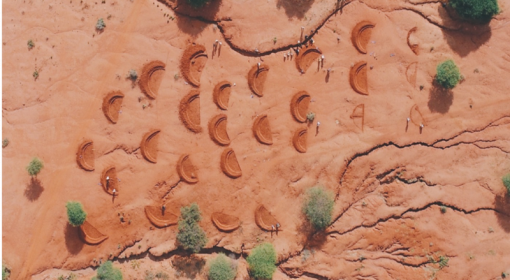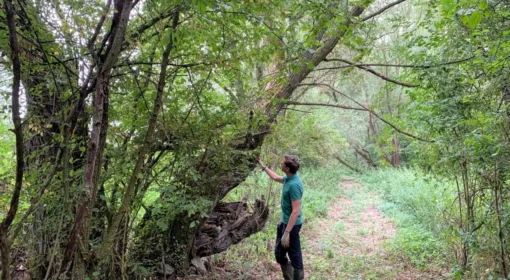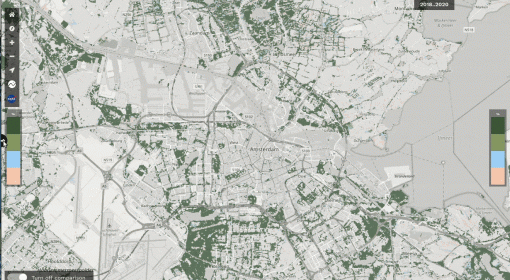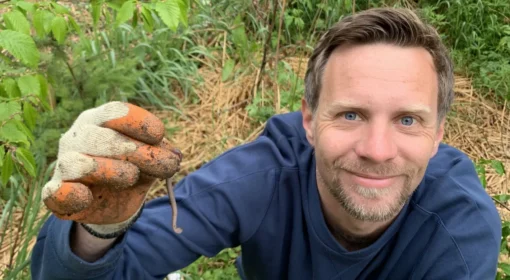by Laura Blok, MetaMeta
Trees are of enormous importance to the ecosystems and livelihoods of people on earth. Many communities depend on forests, such as indigenous people in the Amazon, farmers in Papua and people employed in the forestry sector in Canada and Siberia. Trees are a source of food, fuel and fibre and therefore provide an income to millions of people around the world. In addition to producing valuable products, trees can contribute to climate adaptation and mitigation. This blogpost focuses on how roadside tree planting can contribute to climate mitigation.
Roadside tree planting
Roadside tree planting can make significant improvements to the quality of roads and the environment and can protect key natural resources. Due to the deep root structure of roadside trees, the soil is more stable, and water is better retained in the soil, avoiding the loss of water to deep percolation. Also, trees slow down the flow rate of runoff water coming from the roads, improving the infiltration of water into the soil. The more stable soils, together with the lower runoff velocity, reduce the intensity of soil erosion. Other advantage of roadside tree planting is that the vegetation traps dust that rising from gravel roads, protecting crops on adjacent agricultural land from degradation. They also protect roadside communities and livestock from health issues. Next to these benefits, roadside tree planting can contribute to climate mitigation by absorbing CO2 from the atmosphere.
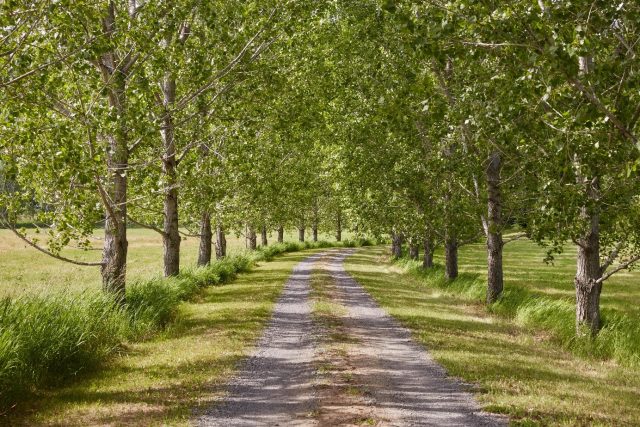
Carbon uptake and release by trees
Trees are seen as the lungs of the earth that produce and release oxygen into the atmosphere. This is part of the photosynthesis process that takes place in every plant. For the process of photosynthesis, water, energy, and CO2 are needed. Plants absorb water and minerals through their roots and take up CO2 and sunlight from the atmosphere via their leaves. The water travels to the leaves, where the sun’s energy converts CO2 and water into glucose and oxygen. The plant releases the oxygen into the atmosphere and the glucose is the energy used by plants for growth and maintenance. (EcoTree, 2021)
![]()
In trees, almost half of the dry biomass is made up of carbon molecules (EcoTree, 2021). These molecules are used for the construction of new biomass. Some of the molecules are used for maintenance and growth and respire back into the atmosphere (USDA, 2014). The net carbon sequestered or the net primary productivity is the amount of carbon that a plant takes in during photosynthesis, minus the amount of carbon a plant releases during respiration (NASA Earth Observatory, 2016). The net primary production depends on the growing conditions of a plant, such as water availability, temperature, sunlight, nutrient availability, and the age of a tree.
So, it seems clear that trees store carbon and act as so-called “carbon sinks”. But it is more complicated than that because the net carbon storage depends very much on what happens to both the trees and the land they stand on after the trees are harvested. Carbon is stored in the form of biomass but can be released after the tree is dead, or through deliberate/ unintended results of human activities such as fires or deforestation. A dead tree will eventually decompose completely, releasing some of the stored carbon into the atmosphere and some into the soil. Bacteria and fungi can also absorb carbon but will release it back into the soil and atmosphere once they die. After forest fires or if wood is burned, almost all carbon stored in the trees or wood is released into the atmosphere (Leander, 2021). A way to store carbon for a long time, is to use harvested trees as construction material for e.g. houses or furniture (CO2 Bos, n.d.). This is an efficient way of storing carbon for decades, if the former land of the trees is used for reforestation again, so that carbon can be stored in the new, young trees (CO2 Bos, n.d.).
Although mature trees do not absorb any more CO2 if they are fully developed, the carbon remains in the tree while it is still alive. Deforestation has on average an emission of 499 ton CO2-equivalent per hectare, so postponing the harvest of a tree can save early carbon emissions (Boosten et al., 2020). The best is to harvest a tree just before its death to avoid natural decomposition of the tree, to use the wood as construction material or decoration and finally plant new trees on the land to prevent land-use change and grow new trees to sequester carbon.
Planting designs
Roadside tree planting is possible in different planting designs. The most common design is ‘avenue plantation’ where trees are planted in a uniform pattern with trees of the same age and species and a distance of 4 to 8 meter between them (depending on the species) (Boosten et al., 2020). On the other hand, vegetation strips are possible where tree and shrub species that differ in age are planted. This design lowers the risk of pest and diseases and increases the biodiversity. The carbon storage of these vegetation strips is lower than of avenue plantation because the CO2 uptake per tree decreases with narrower spacing due to the greater intra-specific competition for CO2 and sunlight. Besides, trees absorb mostly more CO2 than shrubs or other smaller plants (Ragula & Chandra, 2020).
Carbon sequestration of trees along roads
Carbon sequestration by trees is difficult to measure and depends on the tree species, age of the tree and climatic conditions at the tree’s location. The three most important climate variables are light availability, temperature, and soil moisture availability. Fast-growing trees absorb a lot of CO2 in a relatively short time, while trees with a long growth cycle absorb CO2 at a slower rate but they usually produce higher quality timber. When a seedling, the growth rate and therefore the CO2 uptake of a tree is low. After a few years a tree grows more rapidly, increasing the CO2 uptake until the tree becomes mature. At this point, a tree does not grow anymore and the take up of CO2 stagnates, but the stored carbon remains in the tree. At late senescence stage, an old tree becomes a net carbon emitter because more wood is dying and decaying than there is growing. It is therefore vital to manage the trees well and to make sure that trees are harvested at the right point before they reach the stage of decay.
A tree sequesters between 10 and 40 kilogram of CO2 per year, whereas trees located in tropical climates sequester more carbon than trees in temperate and boreal regions. On average, a tree in a temperate climate that reaches the age of 40 years, will sequester about 22 kilogram CO2 per year (Boosten et al., 2020). Table 1 gives an overview of carbon sequestration of different planting designs in a boreal, temperate, and tropical climate. These figures are based on an average sequestration of 22 kilogram CO2 per tree per year, which is applicable for temperate regions. In boreal areas these numbers are lower by a factor of 0.66 and in tropical areas the numbers are higher by a factor of 1.33 (Zeng et al., 2013). As mentioned, avenue plantation are rows of trees with 4 to 8 meters spacing, whereby it is important that all trees get enough sunlight to develop properly. Another possibility is to plant a strip, a so-called “wooden bank”, with different types of trees and shrubs at a short spacing in between. This measure generally absorbs slightly less CO2 for the same area of avenue planting because there is more intraspecific competition for CO2 and sunlight. Table 1 also shows the average annual CO2 sequestration of forests per hectare along roads for boreal, temperate, and tropical regions.
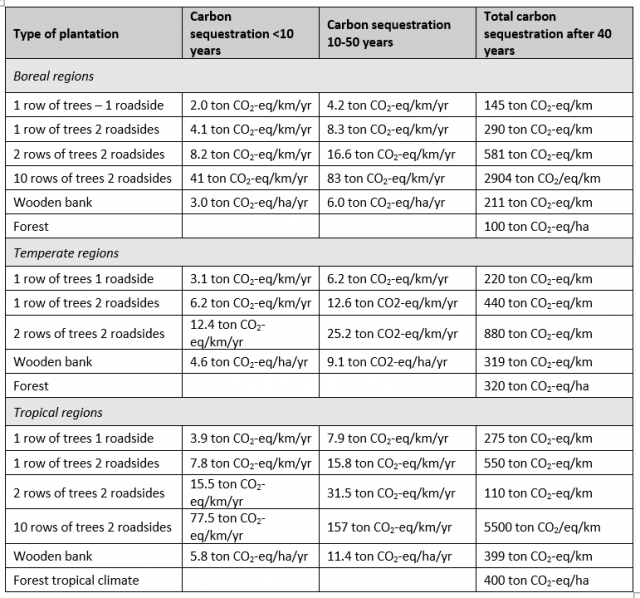
Discussion
The road transport and construction sectors contribute heavily to CO2 emissions and need to find solutions to better adapt to and, especially, mitigate climate change, to comply with the Paris Agreement. Car companies can think about developing cars that are more efficient in their energy use or that drive on more sustainable forms of energy such as hydrogen or electricity. Road construction companies can add circularity and sustainability to the road sector by using more sustainable materials and production processes, extending the life span of roads to reduce maintenance activities and recycling resources, materials and waste (GWW, 2020). By implementing trees in the design of a road, road construction companies can reduce their net CO2 emissions. Planting trees should not be the focal point for making the sector more sustainable: real differences can only be made by creating solutions that emit less CO2 into the atmosphere. Major differences towards a climate neutral sector should be made with other solutions that focus primarily on reducing CO2 emissions during production, construction, maintenance, and use of the roads. Trees can compensate only a small part of the CO2 emissions of cars and of the construction of roads but can add a bit to lowering the carbon footprint. Planting trees does not guarantee that a tree at the end of its lifetime has sequestered carbon. As mentioned above, good management of trees and the land during and after the trees are harvested is needed. It is essential that harvested trees are not (only) used for fuel, but that the wood remains and is used as e.g. construction material, to avoid later carbon emissions.
Close cooperation with local communities or organisations is important and adds to the quality of roadside tree planting practices. Besides providing them with jobs, it is vital that they are involved in the decision-making regarding the design, planting, management and conservation of the trees. In addition, they have most knowledge on the area, local climate and native tree species and know best which trees are most suitable for the specific location that do best on the soil, fit in the ecosystem and support flora and fauna (Rahman et al., 2015).

